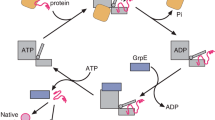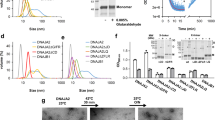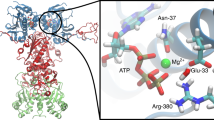Abstract
Peptidyl prolyl cis-trans isomerases can enzymatically assist protein folding, but these enzymes exclusively target the peptide bond preceding proline residues. Here we report the identification of the Hsp70 chaperone DnaK as the first member of a novel enzyme class of secondary amide peptide bond cis-trans isomerases (APIases). APIases selectively accelerate the cis-trans isomerization of nonprolyl peptide bonds. Results from independent experiments support the APIase activity of DnaK: (i) exchange crosspeaks between the cis-trans conformers appear in 2D 1H NMR exchange spectra of oligopeptides (ii) the rate constants for the cis-trans isomerization of various dipeptides increase and (iii) refolding of the RNase T1 P39A variant is catalyzed. The APIase activity shows both regio and stereo selectivity and is stimulated two-fold in the presence of the complete DnaK/GrpE/DnaJ/ATP refolding system. Moreover, known DnaK-binding oligopeptides simultaneously affect the APIase activity of DnaK and the refolding yield of denatured firefly luciferase in the presence of DnaK/GrpE/DnaJ/ATP. These results suggest a new role for the chaperone as a regioselective catalyst for bond rotation in polypeptides.
This is a preview of subscription content, access via your institution
Access options
Subscribe to this journal
Receive 12 print issues and online access
$189.00 per year
only $15.75 per issue
Buy this article
- Purchase on Springer Link
- Instant access to full article PDF
Prices may be subject to local taxes which are calculated during checkout




Similar content being viewed by others
References
Fischer, G., Bang, H. & Mech, C. Biomed. Biochim. Acta 43, 1101–1111 (1984).
Schmid, F.X., Frech, C., Scholz, C. & Walter, S. Biol. Chem. 377, 417–424 (1996).
Hunter, T. Cell 92, 141–143 (1998).
Jabs, A., Weiss, M.S. & Hilgenfeld, R. J. Mol. Biol. 286, 291–304 (1999).
Scherer, G., Kramer, M.L., Schutkowski, M., Reimer, U. & Fischer, G. J. Am. Chem. Soc. 120, 5568–5574 (1998).
Schiene-Fischer, C. & Fischer, G. J. Am. Chem. Soc. 123, 6227–6231 (2001).
Stein, R.L. Adv. Protein Chem. 44, 1–24 (1993).
Pappenberger, G. et al. Nature Struct. Biol. 8, 452–458 (2001).
Zhou, X.Z. et al. Mol. Cell 6, 873–883 (2000).
Ng, K.K.S. & Weis, W.I. Biochemistry 37, 17977–17989 (1998).
Chiti, F. et al. J. Biol. Chem. 274, 20151–20158 (1999).
Thies, M.J.W. et al. J. Mol. Biol. 293, 67–79 (1999).
Bouckaert, J., Dewallef, Y., Poortmans, F., Wyns, L. & Loris, R. J. Biol. Chem. 275, 19778–19787 (2000).
Stoddard, B.L. & Pietrokovski, S. Nature Struct. Biol. 5, 3–5 (1998).
Chiti, F. et al. J. Biol. Chem. 274, 20151–20158 (1999).
Kern, D., Kern, G., Scherer, G., Fischer, G. & Drakenberg, T. Biochemistry 34, 13594–13602 (1995).
Evans, P.A., Kautz, R.A., Fox, R.O. & Dobson, C.M. Biochemistry 28, 362–370 (1989).
Perona, J.J. & Craik, C.S. Protein Sci. 4, 337–360 (1995).
Pinna, L.A. & Ruzzene, M. Biochim. Biophys. Acta 1314, 191–225 (1996).
de Crouy-Chanel, A., Hodges, R.S., Kohiyama, M. & Richarme, G. Biochem. Biophys. Res. Commun. 233, 627–630 (1997).
Zhu, X. et al. Science, 272, 1606–1614 (1996).
de Crouy-Chanel, A., Kohiyama, M. & Richarme, G. J. Biol. Chem. 271,15486–15490 (1996).
Mayer, M.P., Rudiger, S. & Bukau, B. Biol. Chem. 381, 877–885 (2000).
Flynn, G.C., Chappell, T.G. & Rothman, J.E. Science 245, 385–390 (1989).
Langer, T. et al. Nature 356, 683–689 (1992).
Schiene, C., Reimer, U., Schutkowski, M. & Fischer, G. FEBS Lett. 432, 202–206 (1998).
Odefey, C., Mayr, L.M. & Schmid, F.X. J. Mol. Biol. 245, 69–78 (1995).
Gragerov, A., Zeng, L., Zhao, X., Burkholder, W., & Gottesman, M.E. J. Mol. Biol. 235, 848–854 (1994).
Fischer, G. Chem. Soc. Rev. 29, 119–127 (2000).
Schmid, D., Baici, A., Gehring, H. & Christen, P. Science 263, 971–973 (1994).
Kuzmic, P. Anal. Biochem. 237, 260–273 (1996).
Scholz, C. et al. Biol. Chem. 379, 361–365 (1998).
Szabo, A. et al. Proc. Natl. Acad. Sci. USA 91, 10345–10349 (1994).
Baine, P. Magn. Res. Chem. 24, 304–307 (1986).
Diamant, S., Ben-Zvi, A.P., Bukau, B. & Goloubinoff, P. J. Biol. Chem. 275, 21107–21113 (2000).
Acknowledgements
We thank F.U. Hartl for providing the DnaK plasmid, K.-P. Rücknagel for amino acid sequence analysis, D. Wildemann and G. Jahreis for syntheses and B. Korge, K. Walther, R. Steuding and M. Seidel for excellent technical assistance. We are grateful to J. Page for critical reading of the manuscript.
Author information
Authors and Affiliations
Corresponding author
Ethics declarations
Competing interests
The authors declare no competing financial interests.
Rights and permissions
About this article
Cite this article
Schiene-Fischer, C., Habazettl, J., Schmid, F. et al. The hsp70 chaperone DnaK is a secondary amide peptide bond cis-trans isomerase. Nat Struct Mol Biol 9, 419–424 (2002). https://doi.org/10.1038/nsb804
Received:
Accepted:
Published:
Issue Date:
DOI: https://doi.org/10.1038/nsb804
This article is cited by
-
The Hsp90 machinery facilitates the transport of diphtheria toxin into human cells
Scientific Reports (2017)
-
A novel Hsp70 inhibitor prevents cell intoxication with the actin ADP-ribosylating Clostridium perfringens iota toxin
Scientific Reports (2016)
-
The selective roles of chaperone systems on over-expression of human-like collagen in recombinant Escherichia coli
Journal of Industrial Microbiology and Biotechnology (2014)
-
Stereochemical errors and their implications for molecular dynamics simulations
BMC Bioinformatics (2011)
-
Converging concepts of protein folding in vitro and in vivo
Nature Structural & Molecular Biology (2009)



